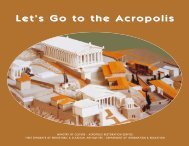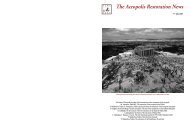The Olympian Gods at the Parthenon Frieze
The Olympian Gods at the Parthenon Frieze
The Olympian Gods at the Parthenon Frieze
Create successful ePaper yourself
Turn your PDF publications into a flip-book with our unique Google optimized e-Paper software.
<strong>The</strong> Par<strong>the</strong>non<br />
<strong>The</strong> Par<strong>the</strong>non, <strong>the</strong> gre<strong>at</strong> temple th<strong>at</strong><br />
domin<strong>at</strong>es <strong>the</strong> A<strong>the</strong>nian Acropolis, was built<br />
by <strong>the</strong> leading st<strong>at</strong>esman Pericles, in honour<br />
of <strong>the</strong> goddess A<strong>the</strong>na, by <strong>the</strong> architects<br />
Ictinus and Callicr<strong>at</strong>es from 447 to 438 B.C.<br />
<strong>The</strong> famous sculptor Pheidias, a personal<br />
friend of Pericles, had general responsibility<br />
for supervising <strong>the</strong> entire project.<br />
<strong>The</strong> temple has always been famous for <strong>the</strong><br />
unprecedented wealth of its sculptural<br />
decor<strong>at</strong>ion, which comprised <strong>the</strong> gre<strong>at</strong> gold<br />
and ivory st<strong>at</strong>ue of <strong>the</strong> A<strong>the</strong>na Par<strong>the</strong>nos, 13.5<br />
metres high, in <strong>the</strong> cella, <strong>the</strong> east pediment with<br />
<strong>the</strong> Birth of A<strong>the</strong>na, <strong>the</strong> west pediment with <strong>the</strong><br />
Contest between A<strong>the</strong>na and Poseidon for <strong>the</strong><br />
privilege of being <strong>the</strong> guardian divinity of <strong>the</strong><br />
city, <strong>the</strong> 92 metope reliefs with <strong>the</strong> B<strong>at</strong>tle of <strong>the</strong><br />
Giants, <strong>the</strong> Sack of Troy, <strong>the</strong> Amazonomachy<br />
and <strong>the</strong> Centauromachy on <strong>the</strong> east, north, west<br />
and south sides, and <strong>the</strong> Ionic frieze<br />
representing <strong>the</strong> Pan<strong>at</strong>henaic procession.<br />
<strong>The</strong> Par<strong>the</strong>non <strong>Frieze</strong><br />
<strong>The</strong> Par<strong>the</strong>non frieze is a continuous relief band,<br />
running along <strong>the</strong> top part of <strong>the</strong> outside wall of<br />
<strong>the</strong> main temple, within <strong>the</strong> outer colonnade. Its<br />
total length was 160 meters while its height was<br />
approxim<strong>at</strong>ely one meter. Rich colours and<br />
added metal <strong>at</strong>tachments were used to<br />
decor<strong>at</strong>e <strong>the</strong> individual figures th<strong>at</strong> stood out<br />
against a deep blue ground.<br />
<strong>The</strong> frieze illustr<strong>at</strong>es <strong>the</strong> gre<strong>at</strong> procession of<br />
<strong>the</strong> A<strong>the</strong>nians to <strong>the</strong> Acropolis, in honour of<br />
goddess A<strong>the</strong>na during <strong>the</strong> Pan<strong>at</strong>henaia<br />
festival. Participants in <strong>the</strong> composition were<br />
360 divine and human figures and more than<br />
250 animals, most of <strong>the</strong>m horses. Competing<br />
groups of riders and charioteers take up most<br />
of <strong>the</strong> procession. <strong>The</strong>re follows <strong>the</strong><br />
procession of <strong>the</strong> sacrificial animals as well as<br />
<strong>the</strong> groups of men and women bringing <strong>the</strong><br />
holy ritual vessels and <strong>the</strong> offerings.<br />
<strong>The</strong> Peplos Scene<br />
Depicted in <strong>the</strong> middle of <strong>the</strong> east side, above<br />
<strong>the</strong> entrance to <strong>the</strong> temple, is <strong>the</strong> culmin<strong>at</strong>ion<br />
of <strong>the</strong> festival, <strong>the</strong> handing over of <strong>the</strong><br />
"peplos", a new robe, <strong>the</strong> gift of <strong>the</strong> A<strong>the</strong>nians<br />
to <strong>the</strong> ancient heaven-sent wooden cult st<strong>at</strong>ue<br />
of A<strong>the</strong>na.<br />
Five figures appear in <strong>the</strong> central scene. Three<br />
females, two carrying <strong>the</strong> sacred stools and a<br />
larger one, perhaps a priestess who leeds <strong>the</strong>m.<br />
A reverent male figure, propably <strong>the</strong> Archon-<br />
King and a boy hold <strong>the</strong> peplos.<br />
Which of <strong>the</strong> two receive <strong>the</strong> peplos to present<br />
it to <strong>the</strong> goddess A<strong>the</strong>na? Justify your answer.<br />
<strong>The</strong> <strong>Olympian</strong> <strong>Gods</strong><br />
To <strong>the</strong> left and right of <strong>the</strong> peplos scene, are<br />
illustr<strong>at</strong>ed se<strong>at</strong>ed <strong>the</strong> twelve <strong>Olympian</strong> gods,<br />
executed with exceptional skill. <strong>The</strong>se must<br />
have been sculpted by <strong>the</strong> gre<strong>at</strong> and famous<br />
sculptors of <strong>the</strong> day such as Pheidias,<br />
Agorakritos and Alkamenes, who all took part in<br />
this outstanding project.<br />
Look <strong>at</strong> <strong>the</strong> wonderful heads, <strong>the</strong> beautiful<br />
clo<strong>the</strong>s, <strong>the</strong> outstanding throne!<br />
Try to identify <strong>the</strong> deities and justify your<br />
identific<strong>at</strong>ion. Carefully note <strong>the</strong> hierarchical<br />
position <strong>the</strong>y have in <strong>the</strong> composition, <strong>the</strong><br />
rel<strong>at</strong>ionship between <strong>the</strong>m and <strong>the</strong>ir<br />
characteristic <strong>at</strong>tributes (or symbols) th<strong>at</strong> <strong>the</strong>y<br />
hold and which you recognize from mythology.<br />
<strong>The</strong> Acropolis restor<strong>at</strong>ion project is co-funded<br />
by <strong>the</strong> European Union.<br />
© YSMA - Department of Inform<strong>at</strong>ion and Educ<strong>at</strong>ion<br />
<strong>Frieze</strong>block IV, British Museum<br />
MA 855<br />
<strong>Frieze</strong>block V, British Museum<br />
Drawings: M. Korres ñ Photographs: S. Mavromm<strong>at</strong>is<br />
Ministry of Culture ñ Acropolis Restor<strong>at</strong>ion Service<br />
<strong>The</strong> <strong>Olympian</strong> <strong>Gods</strong><br />
<strong>at</strong> <strong>the</strong> Par<strong>the</strong>non <strong>Frieze</strong><br />
First Ephor<strong>at</strong>e of Prehistoric & Classical Antiquities<br />
Cornelia Hadziaslani<br />
Design and Layout: AltSys ISBN: 960-214-475-0<br />
Department of Inform<strong>at</strong>ion and Educ<strong>at</strong>ion<br />
<strong>Frieze</strong>block VI, Acropolis Museum
KÂÚ‰ˆÔÛ<br />
B·Î¯ÔÛ<br />
K·ÚappleÔÊÔÚÔÛ<br />
TÂȯÂÛÈappleÏÂÈÎÙËÛ<br />
‚·ÛÙË<br />
MÂÁÈÛÙÔÛ<br />
·ÏÏ·Û<br />
X·Ï΢Û<br />
EÓ·ÏÈÔÛ<br />
MÔ˘ÛËÁÂÙËÛ<br />
ÔÙÓÈ· £ËÚˆÓ<br />
AÊÚÔÂÛÛ·<br />
ram<br />
cedar<br />
pan<strong>the</strong>r<br />
ivy<br />
pig<br />
whe<strong>at</strong><br />
dog<br />
apple tree<br />
peacock<br />
pomegran<strong>at</strong>e<br />
eagle<br />
oak tree<br />
owl<br />
olive tree<br />
donkey ?<br />
horse<br />
pine tree<br />
dolphin<br />
laurel<br />
deer<br />
cypress<br />
dove<br />
rose<br />
God<br />
God<br />
Goddess<br />
God<br />
Goddess<br />
God<br />
Goddess<br />
God<br />
God<br />
God<br />
Goddess<br />
Goddess<br />
Symbols<br />
Symbols<br />
Symbols<br />
Symbols<br />
Symbols<br />
Symbols<br />
Symbols<br />
Symbols<br />
Symbols<br />
Symbols<br />
Symbols<br />
Symbols








